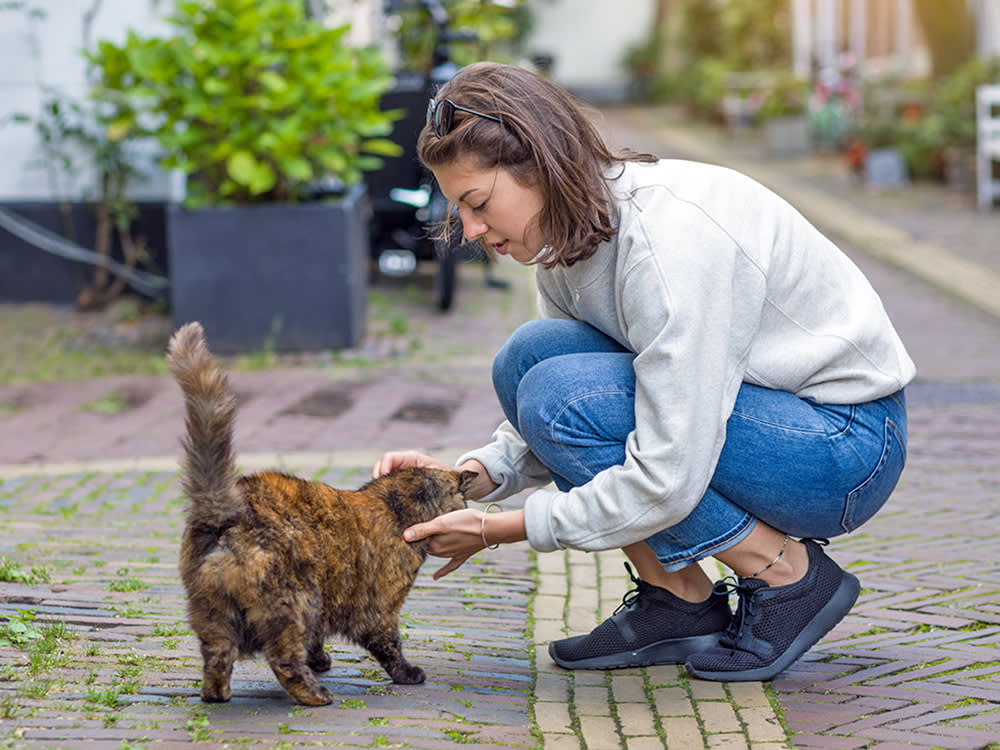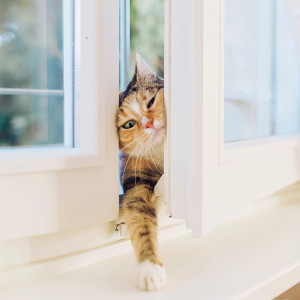Supporting Stray Cats: How to Find Free Veterinary Help
Found a stray cat? Here’s how to get them medical care for free.

Share Article
If you’ve ever spotted a lonely-looking cat wandering around your neighbourhood, you might not only wonder if they’re OK, but also whether they’re a stray or in need of veterinary care. But can you actually take a stray cat to the vet? And if so, will you need to pay?
The short answer is yes, you can take a stray to the vet. However, things are a bit more varied when it comes to cost. Many veterinary clinics charge for services, but there are some programmes and organisations in the UK that can help cover the cost of treatment for stray cats. So let’s dive into how you can help that cute nomad without breaking the bank.
How to tell if a cat is a stray
Before you rush off to the vet, it’s important to establish whether or not the cat you’ve found is truly a stray. A stray cat is one that doesn’t have a pet parent or has been abandoned, while a lost cat could simply be out of its home temporarily (if they appear well-groomed and are a healthy weight, they may have a home and a pet parent nearby).
Then there are also feral cats, who may live happily on the streets and have been neutered and re-released.
The difference between feral, stray and pet cats
While feral cats behave like wild animals and won’t come close to humans, even with encouragement, stray cats might look lost and disorientated, but may be friendly if given time. Cats Protection offers a visual guideopens in new tab to help you identify the difference.
Signs a cat is a stray
Appearance: stray cats often look scruffy, with matted fur, missing patches of fur or wounds. However, this isn't always the case, as some cats may look like they have a home when they don’t; or may look like strays when they’re not. If you see a well-groomed and healthy looking cat, start by speaking to neighbours or putting up signs in case they’re someone’s lost pet.
Behaviour: stray cats may be skittish or wary of humans, as they may have had negative experiences with people. These kinds of cats may be a little shy, often approaching humans with caution if given time and encouragement. Alternatively, they may seem overly friendly, desperate for attention and food – all signs of a cat who has been abandoned or neglected.
Alone: while feral cats often live in groups, a stray cat will likely be alone.
Location: strays and lost cats are likely to be found near people’s homes and gardens, hunting for food or seeking shelter.
Lack of identification: if the cat doesn’t have a collar or identification tag, it may be a stray. Of course, lots of cats who have homes don’t wear collars – so this is not a foolproof way to determine if they are stray or not but it could be an indicator to take them to the vet and get them scanned for a microchip.
Health: strays often show signs of poor health, like sneezing, coughing or a limp, especially if they’ve been living outside for a while.
If you’re still unsure, a quick trip to the vet to check if the cat is microchipped can help clarify things.
What to do with a found cat
Cats Protection offers the following advice for what to do if you find a cat who seems like a stray.
Avoid feeding it unless it is particularly underweight – this will only encourage the cat to come back, even if they have a home.
List the cat on your local community Facebook page or put up posters.
If you think the pet cat may have been neglected or treated cruelly, contact the RSPCAopens in new tab.
If you are able, and the cat seems comfortable and open to being handled, take the cat to a vet to be checked for a microchip.
How to tell if a cat is microchipped
One of the most reliable ways to check if a stray cat is someone’s missing pet is by seeing if they are microchipped. Microchipping is a simple procedure where a small chip is inserted under the cat’s skin, which can be scanned for identification. In England, it’s now mandatory by lawopens in new tab to microchip all pet cats by the time they are 20 weeks old, and the cat parent’s contact details must be registered on a Defra-approved microchipping database.
How to check:
Visit a vet: most veterinary clinics have scanners that can quickly detect a microchip. Even if you don’t take the cat to the vet for treatment, you can bring it in just to check for a chip. While some vets may offer free microchip scans for stray cats, it’s best to confirm with your local vet as some may charge a small fee.
RSPCA, Cats Protection or animal shelters: if you’re unable to visit a vet, the RSPCA, Cats Protection or local animal shelters may offer free microchip scanning. But again, it’s best to call your local branch before heading out as they often just don’t have the resources or time to scan healthy stray cats.
What to do if you find a sick, injured or pregnant stray cat?
An RSPCA spokesperson offered the following advice on what to do if you find an injured stray or feral cat and they’re approachable.
If you’re taking a sick or injured stray cat to the vets and the cat just needs minimum care, you might be expected to take the cat away and fit a paper collaropens in new tab if needed to track down the owner.
If you’ve found a pregnant cat, unless she appears to be sick or injured, there’s usually little to worry about. She’ll probably have a home and owner nearby, or she may be a healthy stray. The RSPCA understands you may be worried about the cat and want to help, but sometimes it can be best to leave the mum-to-be alone. If she is in labour, give her space and try not to disturb her. You can leave her a little bowl of water and a shelter nearby should she need it, whilst you try to track down an owner.
If a cat in labour appears lethargic, distressed or struggling please contact a vet immediately.
If you find a healthy mum and kittens in a safe area, it’s best to leave them alone - don’t move them unless they’re at risk. If you can’t find an owner and you think mum is a stray, call your local animal rescue for advice. They may talk to you about giving a helping hand by providing food, water and outside shelter to help protect mum and kittens from extreme weather. However, if they appear sick or injured please contact your local vet for advice.
If you’ve found a young, stray kitten without their mum and in need of help please contact a vet or local rescue organisation.
If you’ve found an injured or sick stray cat or kitten on a busy road, please do not put yourself in danger – contact the emergency services.
Options for free vet care in the UK
RSPCA
Unfortunately, the RSPCA has to prioritise rescuing animals from some of the worst cases of neglect and cruelty, which means they do not have the resources to take in stray cats. An RSPCA spokesperson explains: “Cats are incredibly resourceful, which means some stray cats are quite happy being stray cats and live great lives. However, there are a number of ways the public can help stray catsopens in new tab including putting a paper collar on them to find an owner, or leaving out some food.”
Blue Cross
The Blue Cross recommends taking a stray cat to your local vet first to check for a microchip. If there is no microchip, you can contact your nearest Blue Cross rehoming centreopens in new tab to see if they have space to look after them.
While Blue Cross finds homes for many stray cats each year, “We are only able to take them in if we have space. If we are unable to take the stray cat in, we can signpost you to other nearby rescues.”
Cats Protection
While Cats Protection doesn’t offer entirely free vet care for stray cats, they do offer financial assistance for neutering and may neuter feral cats, and they also offer advice and resourcesopens in new tab for finding and caring for stray cats.
Battersea
Battersea do take in stray cats, between 9am and 5pm only. They recommend contactingopens in new tab them first before bringing the cat in.
PDSA
While the PDSAopens in new tab does offer free and reduced cost veterinary services to eligible pet parents, it does not have the resources to take in or look after stray cats. But if you decided to adopt the stray cat and you met the eligibility criteriaopens in new tab, you could in theory get the cat treated by the PDSA for free.
Local clinics and resources
According to Cats Protection, “Most vets in the UK provide emergency treatmentopens in new tab and care to sick or injured animals at no cost to the finder.” You may also find other local rescue centres with links to vets, who can take the stray cat in and pay for their treatment through charitable donations.
How to safely capture and transport a stray cat
If you’ve determined that there’s a strong chance the local nomadic feline is a stray and you’re wondering how to safely capture and transport it to the vet to be scanned for a microchip, here’s a step-by-step guide to make the process as smooth and stress-free as possible:
Keep calm: stray cats can be scared or aggressive, so remain calm and move slowly to avoid startling the animal.
Protect yourself: wear gloves when handling a stray cat to avoid scratches and potential transmission of diseases.
Use a cat carrier: the best way to transport a stray cat is in a secure carrier. If you don’t have one, you can use a large box with holes for ventilation.
Lure with food: if the cat is hesitant, you can try to coax it into the carrier with some food. Once the cat is inside, gently close the door.
Transport safely: once the cat is secure, drive carefully to the vet. Don’t leave the cat unattended in the car.
Final thoughts: free vet care for stray cats
If you encounter a stray cat, it’s important to first assess if it's truly a stray, feral or a lost pet, as the approach may differ. If it seems stray or feral, the next step is to take them to get scanned for a microchip at your local vet – usually free of charge.
In terms of vet care, while you can absolutely take a stray cat to the vet, it all depends on the clinic and whether the case is deemed as ‘emergency care’ as to whether they will charge for vet services. Blue Cross and Cats Protection can offer assistance and guidance about what to do with a stray cat and may be able to recommend rescue centres; and Battersea might be able to take a stray cat in if you call ahead first.
Overall, with the right resources and a little patience, you can help ensure the stray cat receives the care it needs.
Free vet care for strays: frequently asked questions
Do vets treat stray cats for free?
In the UK, veterinary care for stray cats is generally not free, but there are some exceptions. Some vet clinics, charities, animal rescue organisations and shelters may offer free or subsidised treatment for stray cats, particularly for essential services like vaccinations, neutering and emergency care.
Local vets may offer discounts or free care for stray cats if they are brought in by a recognised rescue organisation, or in some cases, they might be willing to treat strays for free or at a reduced cost if the cat is in need of urgent care.
How do I take a stray cat to the vet in the UK?
Protect yourself with gloves and see if you can safely lure a stray cat into a carrier using food.
In the UK, can I take my cat to the vet if I have no money?
The PDSA offers free and reduced cost veterinary services to eligible pet parents.
Its reduced cost service is available to eligible pet parents living within the catchment area of a PDSA Pet Hospital or Pet Clinic. They need to be in receipt of one or more of the following benefits to access the service:
Child Tax and Working Tax Credits
Universal Credit (without housing element)
Pension Credit
Income Support
Job Seeker’s Allowance
ESA – (Income Based Only) Employment Support Allowance
Disability Living Allowance (DLA) / Personal Independence Payment (PIP) / Adult Disability Payment (ADP)
State-retired pensioners who are householders in Council Tax bands A-D* are also eligible
Learn more hereopens in new tab.
Cats Protectionopens in new tab may be able to offer advice, and in some cases, help with treatments for your cat, especially if the cat is in urgent need of care.
How long before a stray cat is legally yours in the UK?
In the UK, a stray cat does not automatically become legally yours after a certain period. However, if you find a stray cat and decide to care for it, there are certain legal considerations based on whether the cat is owned or not:
Reporting the cat: if you find a stray cat, the first step is to make reasonable efforts to find its pet parent. You should report it to local animal shelters and check if the cat is microchipped. You should also put up ‘Found’ posters in the area where you found the cat or post on local Facebook groups.
Waiting period: there is no specific waiting period defined by law for when a cat becomes legally yours. However, if you fail to make efforts to locate the cat’s rightful pet parent, you could be seen as acting illegally. But if after a reasonable timeframe (typically seven days), a pet parent cannot be found, and no one claims the cat, you could be seen as its new caretaker.
Microchipping and identification: if the cat has a microchip, the chip will link it to their original pet parent, and you have a legal obligation to attempt to contact them. If you don’t, you might be seen as withholding the pet unlawfully.
Adoption process: if you're hoping to adopt a stray cat, it’s always best to contact local rescue groups or shelters for advice on how to formally adopt the cat. They can guide you through the steps needed to ensure that the adoption is handled legally and ethically.

Ro Elfberg
Ro previously served as Kinship’s Senior Editor. Now a freelancer, she has written and copy-edited for British Vogue, Glamour, DICE and of course, Kinship. When she’s not being manipulated into dishing out Dreamies to Kobe the cat, she spends her free time trying to convince her snake, Butters, to wear a tiny hat.
Related articles
![]()
What to Do If Your Cat Goes Missing
Cats might be curious creatures, but when yours goes missing it can send the most composed pet parent into a spin
![two bonded kittens snuggling]()
Why You Should Adopt a ‘Less Adoptable’ Cat
Here’s why bonded kitties, senior cats and felines with FIV make just as amazing pets as any other
![Tabby cat trying to open with her head window in order to enter the house.]()
Has a Cat Wandered Into Your Life? It Could Be the Cat Distribution System
TikTok thinks the universe just provides you a cat – is that really a thing?
![a woman hugging her cat with blonde hair]()
How Much Does A Cat Cost?
Not sure if you can afford to bankroll a new cat for the rest of its life? Check out our comprehensive guide for all the costs involved




